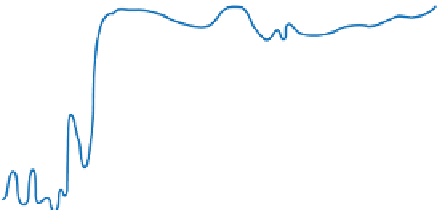Geoscience Reference
In-Depth Information
Age
(years ago)
Oxygen isotope
stage
Medieval
Warm Period
Holocene Climate
Optimum
2
1
Little Ice
Age
0
122,000
0
-1
-2
Average temperature over past
10,000 years = 15°C (59°F)
300,000
-3
-4
5
End of
last Ice
Age
Holocene
Epoch
-5
20,000 10,000 2,000
1,000
200
100
Now
Years ago
900,000
Figure 9.20 Holocene climate changes.
This graph shows
the changes in average surface temperature for the past 20,000
years relative to mean global temperature for the past 10,000
years. Note the dramatic temperature change at the end of the
most recent ice age. Several notable climate fluctuations have
occurred since that time, including the Holocene Climate Opti-
mum, Medieval Warm Period, and Little Ice Age.
10
Glacial period
Interglacial period
15
1,670,000
Colder
Warmer
warmer than the present and the Vikings were able to es-
tablish colonies in southern Greenland. Following this warm
spell, Earth cooled again during the
Little Ice Age
, which oc-
curred from the 13th to 19th centuries. Average global tem-
peratures during this period were about 1°C to 1.5°C (2°F-
3°F) cooler than now.
Figure 9.19 Oxygen isotope stages during the past
approximately 1.7 million years.
Each oxygen iso-
tope stage reflects a glacial or interglacial period, as
indicated through oxygen isotope ratios in marine
sediments. This record indicates that glacial periods
have been quite common during the past ~1.7 million
years. (
Source
: Adapted from N. J. Shackelton and N.
D. Opdyke, 1976. Oxygen-Isotope and Paleomagnetic
Stratigraphy of Pacific Core v28-239, Late Pliocene
to Latest Pleistocene. Geological Society of America
Memoir 145.)
KEY CONCEPTS TO REMEMBER ABOUT
RECONSTRUCTING CLIMATE CHANGES
1.
Understanding past climate change is important be-
cause it provides a window into the potential nature of
future climate changes.
retreated across much of Earth's high latitudes more than 20
times during the Quaternary Period. The most recent of these
glaciations reached its maximum extent about 18,000 years ago
and ended about 10,000 years ago. We will discuss this history
more thoroughly in Chapter 17.
The most recent 10,000 years of Earth history are gen-
erally considered to be the modern climate epoch known as
the
Holocene
. Although Holocene climates have been re-
markably stable compared to earlier glacial cycles, changes
in average Earth temperature have nevertheless occurred
(Figure 9.20). Although several fluctuations occurred during
the Holocene, three are particularly notable. The
Holocene
Climate Optimum
(a.k.a. Hypsithermal) occurred between
9000 and 6000 years ago and was a time when average sum-
mer temperatures in the Northern Hemisphere were 2°C to
4°C (~4°F-7°F) warmer than the present. Another Holocene
warm interval was the
Medieval Warm Period
, which oc-
curred between the 9th and 13th centuries. During this peri-
od, the average global temperature was about
-
0.5°C (~1°F)
2.
The extent and timing of past climate changes can be
reconstructed using indirect clues derived from ancient
pollen, tree rings, and ice cores. Fossil pollen reflects
the kind of vegetation that once lived in an area. Tree
rings provide climate clues because they vary in width
depending on environmental conditions. Ice cores can
be used because they contain a record of oxygen iso-
topes (O-16 and O-18).
3.
The oxygen isotope record indicates that many different
glacial and interglacial periods have occurred during the
Quaternary Period.
4.
The past 10,000 years are referred to as the Holocene
Epoch and have consisted of “modern climate.” Nev-
ertheless, several distinct climate episodes occurred,
including the Holocene Climate Optimum, Little Ice
Age, and Medieval Warm Period.























